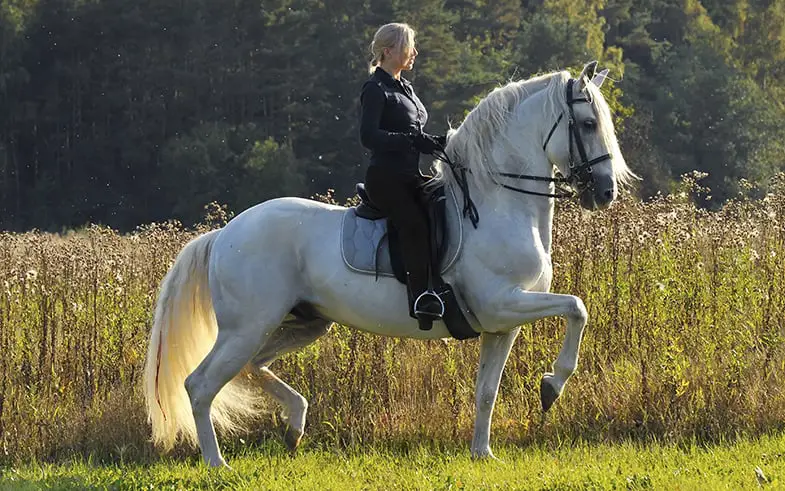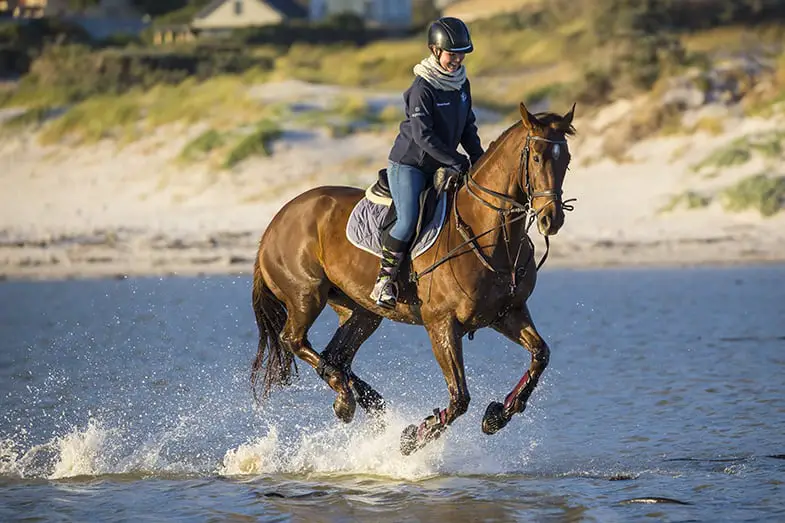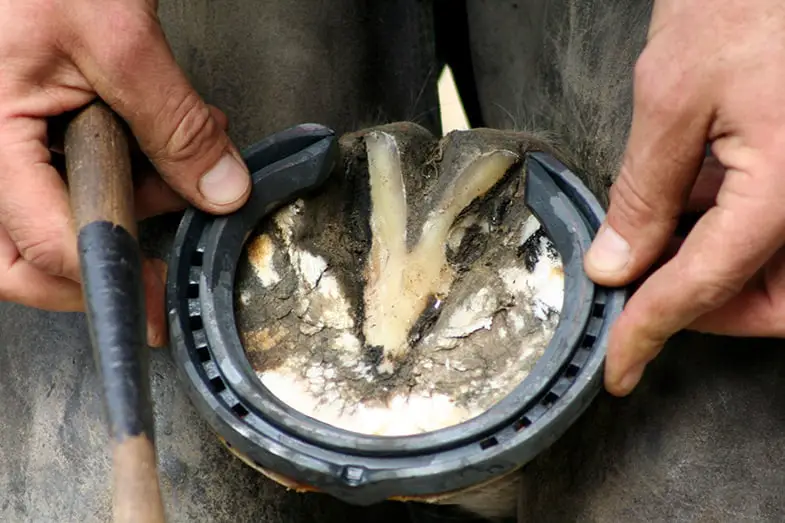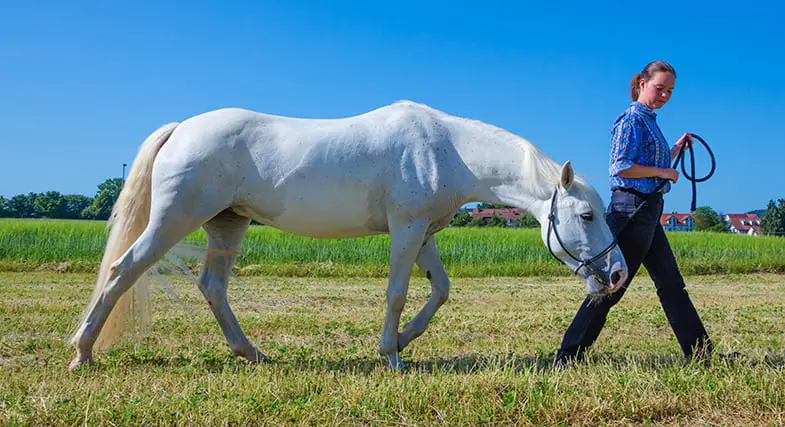The question of whether horse riding is cruel or not is one of those contentious and debatable issues that are always controversial and often difficult to answer because everyone has their own opinion. As an animal lover, this is something that is very close to my heart and something that I’ve done a lot of research into, after all the last thing I want to do is cause any animal to suffer, especially not for my benefit or for the benefit of humans.
When trying to answer this question it’s important to keep an open mind and look at all of the evidence before drawing any conclusions, rather than just reading what you want to for your own benefit. This is something that I’ve been very careful to do when researching and writing this article. Of course, I have my own opinion but after carrying out a lot of research (as well as weighing up all of the arguments) I think you might be surprised by my conclusion.
Is horse riding cruel? Horse riding isn’t cruel if you’re experienced or are supervised by somebody who is. Understanding the horse and how they’re affected by being ridden, as well as learning the correct way to ride is crucial to keeping horse riding cruelty free, as is listening to the horse and how they’re feeling.
Does horse riding hurt the horse?
While we’ve been riding horses for millennia it wasn’t what horses were designed to do, nor what they evolved to do so it’s natural to wonder if it hurts them. It would be easy for me to say that no, horse riding doesn’t hurt them, but that’s only half of the answer. The problem is that horses can sometimes experience pain (especially when being ridden) without us realizing it.
In order to make sure your horse isn’t suffering when you ride it’s important to understand why they might be hiding any pain as well as what to look out for.
Being prey animals horses have evolved to hide their pain so that they don’t fall victim to predators who would look for the weakest horse in the herd. With this in mind, it’s worth pointing out that if your horse is showing signs of pain then it could well be worse than it first seems (unless of course, the horse is a real drama queen!). For example, if the saddle is poorly fitted the horse will carry on normally at first, then will display subtle signs before reacting out of frustration.
It’s also worth pointing out that many of us unintentionally ignore the signs of a horse in pain. We’re all too quick to label the horse’s actions as ‘bad behavior’ rather than investigating the root cause of the behavior. This is why it’s better to rule out any medical problems before blaming the horse for acting up.
The main reasons a horse can suffer pain when being ridden include
- Pre-existing health condition
- Horse’s age
- Leg problems
- Arthritis
- Poorly fitted tack
- Oversized rider
- Inexperienced rider
- Dental problems
If you’re not sure if you’re too big for the horse then you’ll find these articles on how to find the right horse for your weight and height and how much a horse can carry helpful, likewise if you’re not sure when you should stop riding your horse you may be interested in this article on when to retire a horse.
Rather than running the risk of having poorly fitted tack, some people choose to ride without using a saddle at all, or using a treeless saddle but while they both have their advantages you shouldn’t do either all of the time. You should also make sure you’re using the best bit for your horse.
What to become a better rider? How to be a better rider.
Is it cruel to ride a horse in water?
Believe it or not many horses around the world, especially those that live on islands or close to water, actually choose to swim but this is on their own and without a rider. Adding a rider into the equation adds extra weight to the horse and can alter its balance but that doesn’t mean to say it’s cruel.
Like any other form of riding, if you do it properly and consider the horse then riding a horse in water isn’t cruel in any way and can, in fact, be better for the horse. The reason for this is that the water can help the horse to maintain its balance without stressing its muscles or joints.
One thing to point out though is that you shouldn’t ride a horse in water with a tie down or martingale, these will prevent the horse from being able to keep its head above the water and could be considered as being cruel.
Thinking about horse riding in water? Everything you need to know about swimming with your horse.
Do horses enjoy being ridden?
As much as I’d like to say yes horses definitely enjoy being ridden there is sadly there’s no way I can say for sure whether horses enjoy being ridden or simply tolerate it. That said though many riders and owners (including myself) know their horses extremely well and know when they’re enjoying something and when they’re not.
There’s an argument that says horses are big enough animals that won’t do something they don’t want to do. Whether it’s feigning lameness, bucking, rearing, kicking, bolting, or simply throwing the rider off, horses will find a way of not being ridden.
With this in mind, I think we can say that we’d know if a horse doesn’t want to be ridden, after all, if an animal weighing in excess of 1000 pounds doesn’t want to do something you ain’t going to make it do it, no matter how much you try! To some extent, this must mean that at the very least, horses are okay with us riding them.
So why do horses let us ride them if, at best, they tolerate it? There are two arguments for why horses let us ride them, the first of course is that they enjoy it and want to make us happy. The second argument, however, is more likely and is down to the symbiotic relationship we have with them. We provide horses with shelter, protection, food, and medical care as well as companionship and everything they need to stay healthy and happy, and in return they allow us to ride them. This might also be one of the reasons why domesticated horses live, on average, ten years longer than wild horses.
Ever wondered how long domesticated horses live for? How long do horses live?
Is horse riding good for horses?
We’ve talked a lot about whether horse riding is cruel or not but what about the other end of the spectrum, if horse riding actually good for horses? This might seem like a strange thing to ask but you might be surprised to know that, when done properly, horse riding can be beneficial to horses. It can give domesticated horses are more rounded life but is also a good form of exercise and in some cases makes the horse happy, even if just because we’re happy.
More rounded lives
As much as we may want to give our horses a life that’s as close to what their wild lives would have been like it’s simply not possible but riding can help towards this. It gives the horse new experiences and also allows them to explore new areas.
Good for exercise
Wild horses evolved to keep on moving, often covering 10 to 40 miles a day in search of food, but today most horses are domesticated and kept in fields that don’t give them the same space their wild ancestors were used to. This is why exercise is so important for horses and riding them gives them a similar amount of exercise.
On top of that, the exercise itself is extremely beneficial to horses as it helps to build muscle, improve stamina and fitness as well as helps to keep them supple. This in turn improves the horse’s strength and agility, making them fitter and reducing the chance of them straining or injuring themselves.
Exercise is also especially good for horses that are stalled because it helps to release built-up energy.
Ever wondered how far horses can travel? How far can horses run (at different speeds) without stopping?
How to ride a horse without being cruel
As I’ve said horse riding in itself isn’t cruel, although there are things that you can do to ensure it remains cruelty-free.
Warm-up (and down)
Just like us, a horse’s muscles and tendons are stiff and cold before exercise which is why it’s important to warm them up before riding (and down again after). Doing this will reduce the risk of injury as well as the chance of the horse suffering from any discomfort.
You should aim to warm a horse up for at least 10 minutes for every hour you ride, and likewise after a ride.
Pay attention to how your horse moves
Horses will trip from time to time, but if your horse is tripping a lot, walking unevenly, or there’s a change in their gait then it could be a sign something is wrong and you should stop immediately and investigate the problem. It could be there’s something in the horse’s hoof, they’ve thrown a shoe, or something more serious.
Look after your horse’s hooves
There’s an old saying that says no hoof, no horse and it’s so true. Even a small stone stuck in the hoof can cause a lot of problems for the horse which is why you should look after them properly. Not doing so could cause your horse to go lame or possibly even worse.
Even if you’re not intending to ride you should still clean your horse’s hooves every day.
What does it really mean when a horse is lame? Everything you need to know about lameness.
Have regular checks
Having your horse checked regularly by a vet, farrier and equine dentist will help to ensure you deal with any problems before they arise and therefore making sure your horse isn’t suffering any sort of pain.
Keep yourself fit
I know we’re talking about horses but you’d be surprised how much of a role your fitness can play. If you’re fit and have good core strength then you’ll be able to maintain a correct seat and therefore make it easier for the horse to carry you.
Want to improve your core strength? Core exercises that equestrians swear by.
Don’t rely on artificial aids
You should be able to control a horse with your seat, voice, hands, legs, and nothing more. If you do need to use artificial aids such as spurs, draw reins or tie downs then only use them for a short period of time.
Are spurs really necessary? Horse riding spurs: should you really be using them?
Don’t use a whip
I know you’ll probably say that a whip or crop is an artificial aid but, while I do agree, I wanted to put it in a section on its own because it’s something that’s often overlooked. There shouldn’t be any need to use a whip on a horse and it’s should never be used to back up poor or inconsistent commands.
The jury is still out on whether or not the use of the whip hurts the horse, but in my opinion, it’s not necessary and is cruel.
Ask for help
Experience is something that comes with time and horse riding is no different, new riders haven’t learned to sit correctly and stay balanced, nor have they learned to subtly control the horse which is why you should work with an experienced trainer or instructor. They can help to prevent the horse from being overworked as well as prevent musculoskeletal damage.
Horses handled by unsupervised, inexperienced riders can also develop trust issues, anxiety, and even become fearful.
Thinking about learning to ride? From beginner to expert: how long does it take to learn to ride?
Don’t overwork the horse
While horses can cover a lot of ground every day they often do this at a very slow pace so it’s important that you don’t overwork your horse and make sure you give them enough time to recover.
Just because you can’t always ride your horse doesn’t mean you can’t spend time with them and enjoy doing this together. If you’re stuck for things to do then check out this article on fun things to do with your horse that don’t involve riding.
Not sure how often you should ride? How often should you be riding a horse?
Take home message
To some extent the question of whether or not horse riding is cruel will never be conclusively answered, sadly we’re all too opinionated and close-minded for that to ever happen but that doesn’t mean to say there isn’t an answer. Of course, there are aspects of horse riding that are undoubtedly cruel, things such as excessive use of a whip, inexperienced riders using spurs and even working a horse that is clearly in pain, but that doesn’t mean all aspects of horse riding are cruel. If you consider the horse’s needs above everything else, make sure they’re happy, the tack fits correctly and you’re not working them excessively then horse riding isn’t cruel at all.
To sum it up in a nutshell, horse riding isn’t cruel if the rider is considering the horse although the rider can make it cruel if they abuse the horse in any way at all, even if it’s only by ignorance.
Ever wondered whether or not horse riding is vegan? Is horse riding vegan?
I hope you found this article helpful. If you did I’d be grateful if you could share it please as it would really help me.
Recommended products
Over the years I have tried hundreds of different horsey products, from various blankets and halters to different treats. Some I’ve loved, others I’ve hated but I thought I’d share with you my top all-time favorite products, the ones I never leave the yard without. I’ve included links to the products (which are in no particular order) that I really think are great.
- Horse Knots by Reference Ready – If you’re like me and enjoy pocket reference guides then you’ll love this knot tying guide. These handy cards can easily fit in your pocket or attach to the saddle for quick reference. They’re waterproof, durable and are color coded to make them easy to follow.
- Mane ’n Tail Detangler – Even if you never show your horse you’ll need to detangle his tail from time to time (and possibly his mane too) which is always a challenging chore! I’ve found that if I run a little bit of detangler through my horse’s tails every few days it stops them from getting matted up and makes combing them easy, even if they’re coated in mud. I don’t know if I should admit to this or not but it also works wonders on my hair.
- TAKEKIT Pro clippers – Over the years I’ve tried a lot of different clippers and while some were obviously better than others I found these to be by far the best. They are heavier than a lot of other clippers but for me, that’s a good thing, it makes them feel more sturdy and hardwearing. On top of that they have a range of speeds so are just as good for clipping your horse’s back as they are his face. I also like the fact that they come in a handy carry case but that’s not for everybody. The company that makes them is super good and incredibly helpful too, a real bonus these days. The only thing I wasn’t keen on was the fact that it doesn’t come with any oil, but that’s not a major problem as it’s not difficult to buy lubricant.
- Shire’s ball feeder – There are so many boredom buster toys out there but I like to use these every day, regardless of whether or not my horses are bored. I find that it helps to encourage my horses to problem solve by rewarding them with treats (or pieces of fruit) but it also mimics their natural grazing behavior which helps to keep them calm and de-stressed.
- Horse safe mirror – This is a strange one that many people are surprised about but I like to put horse safe mirrors in the trailers as well as in the quarantine stalls. It helps to prevent the feeling of isolation by giving the impression of other horses being around. Being herd animals horses can get extremely stressed when they feel that they’re on their own but with these stick-on mirrors, they believe that at least one other horse is with them.
- Rectal thermometer – I know this isn’t glamourous at all but it’s vital for your horse’s well-being to be able to check their temperature and a rectal thermometer is the easiest way of doing this which is why I’ve added it to the list.
Shopping lists
I’ve also put together a few shopping lists of essential items that I’ve found helpful over the years. I’ve broken the lists down into different categories rather than put everything in one massive list 😉





